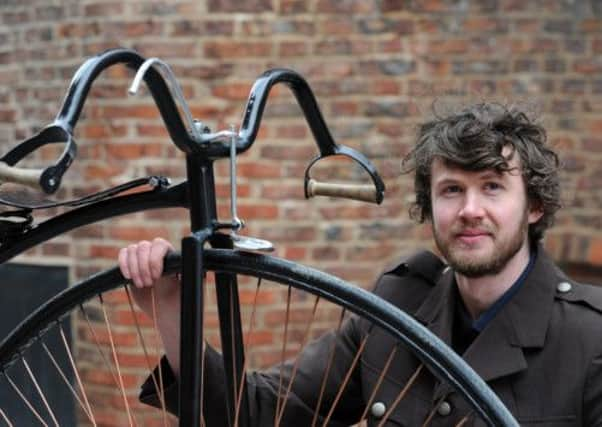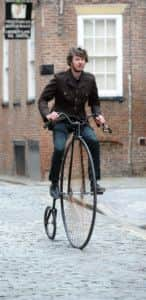Bicyclist steps up a gear with ‘Victorian’ creation


But they can cost thousands of pounds so Christian set about making his own – from recycled parts.
He fashioned 80 brass welding rods into spokes and joined two inner tubes together to make the gigantic 4ft 2in pneumatic wheel, on which he perches on a saddle made out of steel from a washing machine.
Advertisement
Hide AdAdvertisement
Hide AdIt takes some practice to master the art of leaping on and off the high seat.


And Christian admitted feeling nervous as he took the bike for a spin down cobbled High Street in Hull, a stone’s throw from the Streetlife Museum, from where he got his original inspiration.
Dismounting proved even more difficult – explaining why the term “going a cropper” originated from the bikes.
As he slowed down he got pitched forward, making a rough landing.
Advertisement
Hide AdAdvertisement
Hide AdYoung men of the Victorian era were advised to cross their feet over the handlebars when going down hill, so that if they fell off they would fall on their feet rather than “take a header”.
Christian, 26, a computer engineer from Kingswood, Hull, now hopes to make a batch of bikes to sell, including a bike with an even larger wheel, which he should be just about able to reach the pedals of as he stands 6ft 4in.
He put the penny farthing together on odd Sundays in the garage of his home and in all materials cost just £100.
Although he hopes to use the bike now and again, he admits modern traffic does get in the way.
Advertisement
Hide AdAdvertisement
Hide AdHe said: “I was attracted to the idea because of the exclusivity of it – everybody has a normal bike, and you can’t just go and buy a penny farthing. It is really weird because the bike bounces around and the back wheel bounces up and down.
“Because you are sat on top of the wheel you don’t feel as if you are balanced.”
The one unfinished part of the bike is the brake. He said: “I haven’t bothered to set up the brake properly as from what I’ve read it sounds like the most dangerous part.
“You are sat right on top of the wheel and if you braked you’d probably go straight over.
Advertisement
Hide AdAdvertisement
Hide Ad“Technically I’d say probably the wheel rim was the most challenging and the most time consuming was the spokes.”
Although they are known as “penny-farthings”, the term probably didn’t come into use until they were nearly outdated; the first recorded print reference is 1891 in Bicycling News.
The bicycle, which has become an icon of the Victorian era, got its name because its two wheels resemble two coins, the penny and the farthing. Over 200,000 were made between 1870 and 1885.
A “direct-drive” bicycle, the cranks and pedals are fixed directly to the hub. Instead of using a complex and heavy gear system to multiply the revolutions of the pedals, the big front wheel was increase to its maximum radius – 60 inches – to increase the maximum speed.
Advertisement
Hide AdAdvertisement
Hide AdIt became extremely popular among young men of means wanting to cut a dash through the streets, despite the dangers.
According to one history, a head-on collision with a pedestrian at speeds above 12mph had a 100 per cent mortality rate and led to the deaths of over 3,000 people in 1918 alone.
Ironically the nephew of one of the men responsible for its popularity was largely responsible for its demise.
James Starley built the Ariel high-wheeler in 1870; but when chain drives were upgraded so that each link had a small roller, higher and higher speeds became possible without the large wheel.
Advertisement
Hide AdAdvertisement
Hide AdIn 1885, his nephew John Kemp Starley used the latest innovations to launch the Rover Safety Bicycle, which had all the elements of a modern bike, with the rider sitting much lower and farther behind the front wheel.
In the US, the non-profit organisation The Wheelmen keep the memory of bikes like the penny farthings alive with parades, tours and demonstrations. The current record for a “stack” of penny farthings was set in 2003, when 131 of the bikes rode line across a Leicester park.
Christian can be contacted through his website www.richardsofengland.co.uk